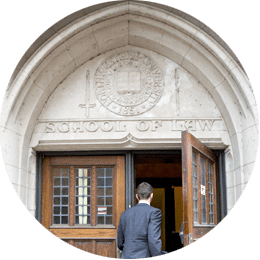News
Q & A with Professor Deborah Tuerkheimer on her book, Flawed Convictions
April 10, 2015
During the 1990s the existence of a specific set of medical findings in certain infant deaths—the concurrent existence of three neurological symptoms: subdural hematoma, retinal bleeding, and cerebral edema—became increasingly used to prove child abuse, and many hundreds of caretakers have been convicted and sent to prison as a result. But the medical community has revised its estimation that the existence of these symptoms, absent other indicators, is proof of child abuse, and in 2008 the Wisconsin Court of Appeals found that “…that a significant and legitimate debate in the medical community has developed in the past ten years over whether infants can be fatally injured through shaking alone.” In Flawed Convictions: “Shaken Baby Syndrome” and the Inertia of Injustice, Professor Deborah Tuerkheimer, a former Manhattan assistant district attorney, examined this medical diagnosis of murder and what these cases mean for the criminal justice system.
How did you first become interested in Shaken Baby Syndrome cases?
I was a prosecutor in the Manhattan District Attorney’s office for five years and among the cases I handled were child abuse and child abuse investigations, so I was trained on Shaken Baby Syndrome. In the course of investigating those cases, I spent time with doctors and had a number of conversations about this diagnosis. Then I became a law professor, and in early 2008, I came across the case of Audrey Edmonds, a caregiver who was convicted based on the kind of evidence I was familiar with. Edmonds’s conviction was overturned by an appeals court in Wisconsin. The court concluded that the science behind the evidence that convicted Edmonds, and other caregivers like her, had shifted decisively. I was really surprised to read this, and because of my work in the DA’s office, I knew that this case was fairly representative of many others. If the science had shifted so significantly that this particular caregiver was entitled to a new trial, the convictions of many others would also be affected. I wondered if the court was right to overturn her conviction. That’s what started me down this path, of delving into the medical research; talking to doctors, defense attorneys, and prosecutors; and reading lots and lots of cases.
Your book focuses on the so-called “triad-only cases,” where the only evidence against the accused was the medical diagnosis. This diagnosis became widely accepted as proof of homicide, and there are many cases where the existence of these three symptoms was enough to get a conviction. What are the three symptoms that form the triad and why are these “triad-only cases” the most problematic?
The “triad” refers to three neurological symptoms that were once thought to prove that a baby had been violently shaken. The three symptoms are: bleeding beneath the outer membrane layer of the brain, also known as subdural hematoma; retinal hemorrhages, which is bleeding in the retina of the eye; and cerebral edema, or swelling of the brain. When doctors found the presence of these three symptoms—sometimes even two and sometimes even one—they would, in the past, diagnose Shaken Baby Syndrome. In the absence of a high-speed car crash or a fall from a multi-story building, doctors believed that the “triad” of symptoms could only be caused violent shaking, and violent shaking by the caregiver last with the baby when the baby was lucid. I’ve called it a diagnosis of murder, because the medical testimony was thought to prove every element of the crime of murder (or felony assault when the baby lived) beyond a reasonable doubt. The medical testimony was the entire case.
The science behind Shaken Baby Syndrome seemed incontrovertible. But in fact it was highly controversial.
In the mid to late 90s, a number of factors converged to cause folks inside the medical community—and outside of it—to take a closer look at Shaken Baby Syndrome. As magnetic resonance imaging became more widely available, it showed radiologists a number of different things about what was going on in the brains of those babies. Biomechanical engineers started doing research that called into question some of the assumptions that were being made about the forces involved in this kind of shaking. There was also a widely influential meta-analysis of the research underlying this diagnosis, and it really challenged the idea that this was sound scientific methodology. This meta-analysis raised serious questions about the validity of the research base that supposedly supported the diagnosis. Then there was a high-profile prosecution of a British au pair named Louise Woodward that drew more attention to this diagnosis as potentially problematic. Pediatricians started to interface more with doctors from other specialties and researchers began paying closer attention to alternative causes of these symptoms. By the late 90s, the consensus about this diagnosis had begun to shift considerably, and while there’s still quite a bit of disagreement about some of the questions that surround it, there is now a good deal of shared understanding about the diagnosis that’s very different from what it once was.
One of the developments that is most important when we’re thinking about how the science of Shaken Baby Syndrome has changed is the recognition that there are many alternative causes of this triad of symptoms. I talk about a shifted consensus, and what I mean is that doctors now agree that it’s not the case that only abuse or only shaking can bring about these three symptoms. There are natural disease processes, there is birth trauma, there are blood disorders, there are genetic explanations. And while there may be some disagreement about what causes now have to be ruled out, there is universal consensus that what’s called the “differential diagnosis,” meaning other causes of the triad of symptoms, is now something that must be considered. In some cases, even after taking into account these various possibilities, we still may not know what happened to the baby. Certainly in cases from the past where the differential diagnosis was not considered, we should be especially concerned that natural causes brought about the baby’s death or injury and that doctors never thought to look into those possibilities.
So there are other causes of the triad of symptoms. Is it also the case that shaking a baby can’t result in only the triad of symptoms, without other signs of abuse?
That’s where the big controversy still lies. Is it possible to bring about the triad of symptoms and only the triad of symptoms (without neck or spine involvement) by shaking? Some people say yes, some people say no. I don’t take a position on that question because my point in the book is that the triad alone is not proof beyond a reasonable doubt of shaking. Certainly the idea that doctors can pinpoint the timing with enough precision to identify a perpetrator has been discredited. It’s now accepted by the medical community that babies can have bleeding of this sort and be lucid, so the idea that the last caregiver with the baby is the certain perpetrator of the shaking is one that can no longer be supported by medical evidence.
It seems the majority of people convicted in the triad-only cases were female caregivers, as opposed to parents. It seems reasonable to suppose the two groups would be convicted at a similar rate; why isn’t that the case?
It’s hard to make definitive conclusions about the numbers here. Until very recently we didn’t know much about who was being charged and what was happening with those cases. Recently, the Medill Justice Project began collecting national data and they have created a publicly available database with information on over 1000 cases. It’s really the first glimpse we have into what’s been going on over the decades with Shaken Baby Syndrome. My sample is smaller and it certainly doesn’t purport to capture the universe of these cases. I focus on triad-only cases in my book, the subset of cases that might be called classic Shaken Baby Syndrome. Other cases might include medical evidence beyond the triad that might have corroborated abuse. But in the triad-only cases—which I believe were at one point the majority of the Shaken Baby Syndrome prosecutions—my sense is that caregivers comprise the bulk of the prosecutions and convictions. Mothers’ boyfriends and stepfathers are a high percentage of these alleged perpetrators as well.
Why was the 2008 exoneration of Audrey Edmonds a transformative moment in the history of these types of cases?
It was the first time that a court really looked at changes in the science underlying the evidence typically presented in a Shaken Baby Syndrome prosecution. After many days of hearing evidence from both sides, the court concluded that the evidence base was insufficient. There had just been such a shift in the science that the conviction couldn’t be sustained. It was a pivotal decision that opened the way for greater scrutiny, additional legal challenges, and subsequently for other courts to find much the same.
You argue that these cases turned traditional evidentiary laws upside down, describing them as “a new crime model, one fully constructed by science.” As the science behind the model has evolved away from certainty, how has the criminal justice system responded?
This is an unsettling part of the story. You can think about the problem as twofold. One is how does the criminal justice system vet science for trial, and what mechanisms do we want to have in place to ensure that, to the best of our ability, we’re only admitting into evidence science that is valid. But then on appeal, we need to be able to revisit those convictions that rest on scientific evidence that, in the interim, has evolved, progressed—as science is wont to do. Our criminal justice system is not particularly adept at doing either of those things. Criminal convictions, unlike science, are for the most part final. It’s exceedingly difficult for a person who’s been convicted to successfully challenge that conviction.
What would tackling the problem on those two fronts look like?
My book has a chapter on reform and both to prevent wrongful convictions and to unravel them. I think judges should be taking a more active role in screening the testimony of experts, and there is a fairly developed body of case law on the civil side that would be really useful here. I suggest that there’s really no reason we should have more aggressive screening mechanisms when money is at stake than when liberty is. I also talk about innocence commissions, the prosecutor’s role in post-conviction review, and the importance of the kind of conviction integrity units we’re increasingly seeing created within prosecutor’s offices.
You talk about the twofold problem: the need to remedy convictions based on flawed science, as well as to stop using the flawed science for new prosecutions. You’ve worked on this issue for a while now; what changes have you seen on both of these fronts since you started?
In the last few years, I’ve seen accelerating change on both fronts. The new cases—and again, just to reiterate, the new triad-only cases—are coming into the system, from what I’ve been able to tell, at a significantly slower rate. Prosecutors are more willing to dismiss charges before ever bringing them to trial, they are more willing not to charge at all, and police investigations are more likely to result in no arrest. Those cases may or may not end up in family court, which is a whole separate site for some of these battles, but many more cases will never enter the criminal justice system. On the post-conviction end, there have been a number of judicial opinions that have questioned the scientific validity of Shaken Baby Syndrome, granting new trials to petitioners in state cases and in one federal case that I think is extremely important: the case of Jennifer Del Prete. Judge Matthew Kennelly, a district judge in the Northern District of Illinois, found what’s called actual innocence in the case. This allows Jennifer Del Prete to proceed with her ineffective assistance claim and a claim that exculpatory evidence was not disclosed when it should have been. This actual innocence finding is really important—Judge Kennelly included in his opinion a passage saying Shaken Baby Syndrome is arguably “more an article of faith than a proposition of science.” For a federal judge to write that is another really important step in the direction of a widespread recognition that there are people sitting in prison who shouldn’t be.
What does this work reveal about larger problems with the criminal justice system as a whole?
One of the troubling aspects of doing this research has been to see how problems that we know exist play themselves out. For example, we know that people can falsely confess to crimes they didn’t commit. In my chapter on interrogation, and in the course of reading interrogation transcripts, I could see many of the dynamics that are risk factors for false confessions in action. Similarly, the importance of competent counsel and the way in which having the resources—or not having the resources—to hire lawyers and experts can make a huge difference. These cases really underscore massive inequities in the criminal justice system, and the reason these inequities are so important to address.
There are so many cases where in hindsight we can look back and say, “What would have made people think that this person violently shook a baby to death?” I wonder: How did this diagnosis become so easily accepted and so readily incorporated into the criminal justice system? I think there is a real cultural anxiety around working mothers, particularly around working mothers of infants, and I wonder what role that may have played into the ease with which this diagnosis made it into the mainstream and into the legal system. And certainly, there is a psychological urge to blame, to convert a tragedy into a crime, that is also at play here. It is important now for us to think about why this came about, so we can try to prevent anything like it from happening again.
- Categories:
- Faculty






